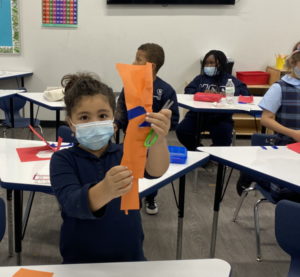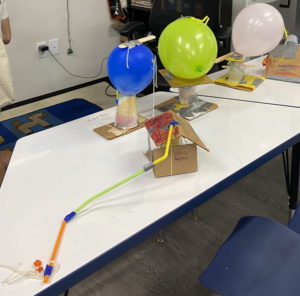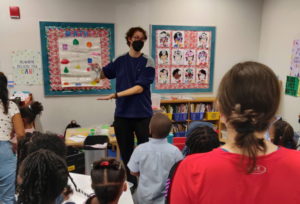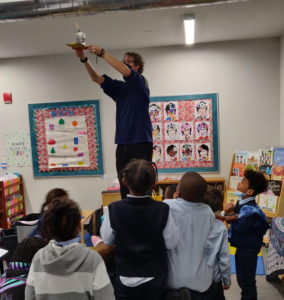On Friday, October 15th, 2021, we had our second reverse field trip of the year! We visited the 1st grade classes at the Mission Grammar School in Mission Hill (Boston). A younger field trip audience than usual (we typically do 4th-8th graders), this field trip was our third ever with Mission Grammar (the teacher we worked with taught 5thh grade in the past taught) and we adjusted our teaching (activities, presentations, student interactions) accordingly for this younger audience. The field trip took place in two adjacent classrooms, room 1 was taught by myself (Nick) with help from Karen and Brendan, whilst the second room was taught by Sam and Maya, with help from Gabriella.
The students started the day off with a quick introduction to engineering (engineers solve problems and engineers persevere through solutions that don’t work!) and then roleplayed civil engineers, designing towers to be as tall as possible using just a single piece of paper and six inches of tape. Inspired by real world buildings, each group worked together to build their structures. Each group (in my room) completed a tower, each with their own unique strengths: such as a wide base to hold the tower, an aesthetically pleasing design, or multiple well-connected support beams.
Next, we did a biomedical engineering activity about protecting the head / brain, a very important body part to protect. To simulate our brains, we used eggs. Just like your skull protects your brain,
an egg shell protects what’s inside: the yolk (the “brain” of the egg). The egg white is like the fluid in the skull called cerebrospinal fluid, which allows the brain to move without hitting the skull. Humans wear helmets to protect their heads (and brains inside), such as when playing sports or driving motorcycles. So for us, we made our own helmet for the egg -> a protective device to protect the egg from harm (when we drop it 10 feet off the ground). Usually when we do this activity, we provide a list of potential supplies and have students “purchase” their supplies with a certain budget. However, with these younger students, we provided a set list of materials, with each group having the same materials: 2 sheets of paper, 3 popsicle sticks, 3 rubber bands, 1 piece of felt, 4 paperclips, 1 length of string, 2 pipecleaners, 1 balloon, 1 plastic cup, 8 packing peanuts, 2 straws, 1 quart-size plastic bag, and 2 pieces of cardboard (~4×4 inches each), and as much duct tape as needed. The most used materials were the cardboard, plastic cup, and packing peanuts (and duct tape), which were used in every design. The paperclips were the least used, with a couple groups even asking me why they were included and what use they had.
Before testing the designs, we had a “control” drop -> i.e. to benchmark the eggs to see if they do indeed break when they hit the ground (they absolutely do!). The egg-protecting designs were all very interesting, with my personal favorite (in picture above) using the string and straws to create a long “spire” at the top of the design -> i.e. the design became very tall, and since I was dropping designs from the top of their design, meant in this case I held onto the string and paperclips and the actual egg was significantly closer to the ground than other designs.
Lastly, we wrapped up with a Q+A sessions where students asked questions about science and engineering and life as an older student (i.e. high school and beyond). This time around, the questions (which the students had helpfully come up with in advance) were much more general science related (rather than college), which wasn’t surprising (as the students are 1st graders), but did end up with some lively responses.





